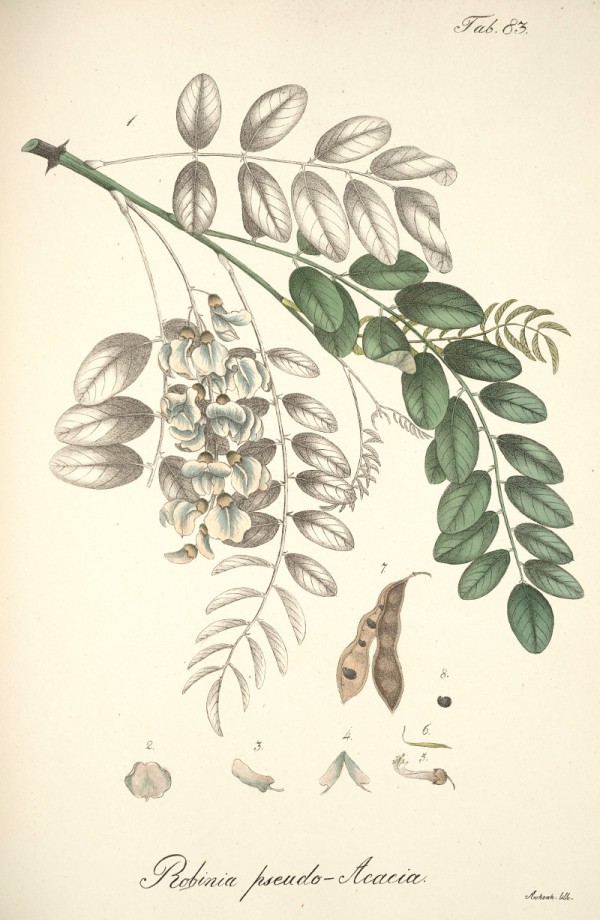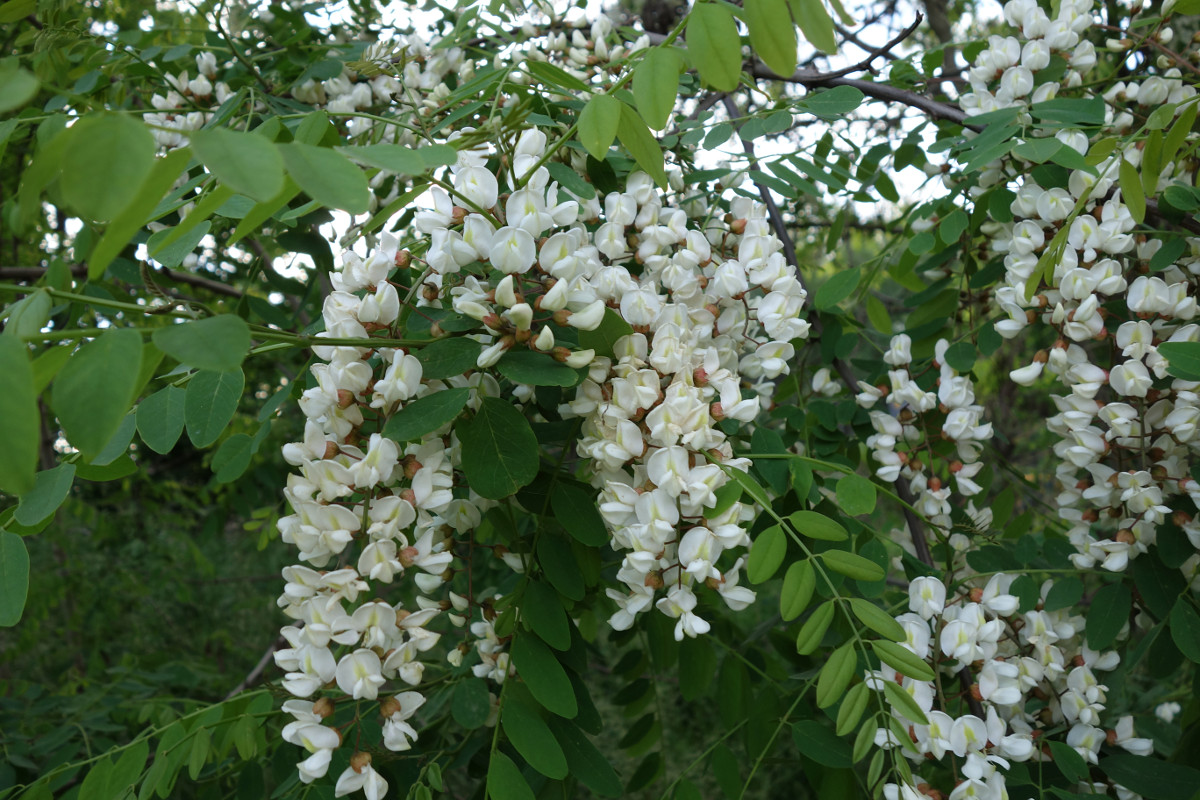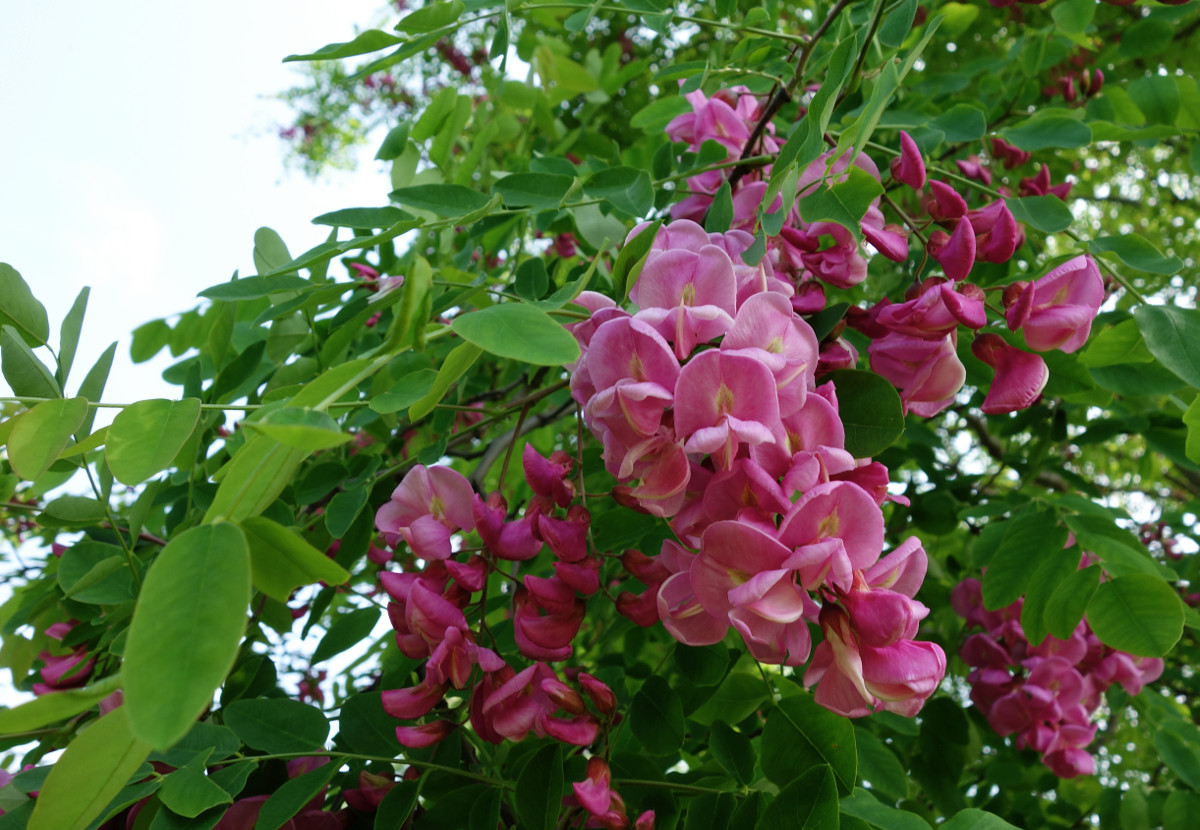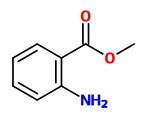Robinia pseudoacacia L. - Fabaceae - black locust, false acacia, Robinie, Falsche Akazie, Scheinakazie
Invasive tree, native to eastern North America, naturalized throughout the world; 15-25m high; inflorescence a pendent cluster; flowers white, fragrant (sweet orange flower/bergamot-like).
„Important constituents of the plant are the toxalbumin robin, which loses its toxicity when heated and robinin, a non-toxic glucoside.“ http://en.wikipedia.org/wiki/Robinia_pseudoacacia
Major constituents of the vacuum headspace concentrate from the flowers were 2-aminobenzaldehyde (31.5%), methyl anthranilate (14.6%), linalool/phenylethanol (18% together), nerolidol (5.3%), α-farnesene (5.1%), and (E)-ocimene (4.4%). Phenylnitroethane, (Z)-3-hexenyl benzoate and 1-octen-3-ol were minor odorants.
„It should be noted that the mass spectrum of 2-aminobenzaldehyde is very close to that of formanilide proposed by most of the commercial mass spectra librabries.“
[Joulain, D. „Study of the fragrance given off by certain springtime flowers.“ Progress in essential oil research (1986): 57-67]
„The floral fragrance headspace of living Robinia pseudoacacia was trapped on Tenax tube cartridges using air as the carrier. After solvent elution, the major components identified using GC/MS were δ-3-carene (54.6%), linalool (21%), (Z)-β-farnesene (3.0%) and anthranilate aldehyde (3.9%).“
[Characterization of black locust floral fragrance. Kamdem, D. P., Gruber, K., Barkman, T., Gage, D. A., Journal of Essential Oil Research, 6(2), 1994, 199-200]
Feeding experiments with 13C- and fluorine-labelled precursors revealed that the biosynthesis of 2-aminobenzaldehyde in flowers of Robinia pseudoacacia and Philadelphus coronarius is realized by transformation of anthranilic acid to indole followed by oxidative ring opening and hydrolysis of the resulting N-formyl-2-aminobenzaldehyde.
[Biosynthesis of 2-aminobenzaldehyde in flowers of Robinia pseudoacacia and Philadelphus coronarius., Spiteller, P., Steglich, W., Phytochemistry, Vol.57(3), 2001, 361-363]
„Volatiles from the fresh flowers of Robinia Pseudoacacia L. grown in China were analyzed by GC-MS combined with solid-phase microextraction (SPME). The abundant compounds identified were linalool (33.1%), cis-β-ocimene (26.6%), (E)-α-bergamotene (8.9%) and formanilide (7.4%).“
[Constituents of top fragrance from fresh flowers of Robinia Pseudoacacia L. occurring in China., Xie, J., Sun, B. and Yu, M., Flavour Fragr. J., Vol.21, 2006, 798-800]
„Black locust wood is being studied to find the chemical basis for its remarkable decay resistance. High flavonoid concentrations (6% of dry weight) are important, especially the constituents robinetin and dihydrorobinetin (Smith et al. 1989). When impregnated into easily decayed woods, heartwood extracts have raised decay resistance to a level equivalent to that attained by commercial wood preservatives (Smith et al. 1989).“
http://www.hort.purdue.edu/newcrop/proceedings1990/v1-278.html
[Extracts from black locust as wood preservatives: extraction of decay resistance from black locust heartwood., Smith, A.L., Campbell, C.L., Walker, D.B., Hanover, J.W., Holzforschung-International Journal of the Biology, Chemistry, Physics and Technology of Wood, Vol.43(5), 1989, 293-296]
„The identification of phenolic compounds by UPLC-DAD-MS/MS revealed, for the first time, the presence of resveratrol and piceatannol. These two stilbenes as well as the flavonoid dihydrorobinetin were present at the highest level in mature heartwood, and as they are known antifungals, they could account for the great durability of mature heartwood. The stilbenes were detected in significant amounts particularly in mature heartwood where piceatannol reached a level tenfold higher than that reported for Japanese knotweed roots, the primary natural source of these stilbenes, whereas resveratrol level was comparable with reported values.“
[Characterization of black locust (Robinia pseudoacacia L.) heartwood extractives: identification of resveratrol and piceatannol., Sergent, T., Kohnen, S., Jourez, B., Beauve, C., Schneider, Y.J., Vincke, C., Wood Science and technology, Vol.48(5), 2014, 1005-1017]

Krebs, F.L., Vollständige Beschreibung und Abbildung der Sämmtlichen Holzarten, t.83 (1826)
http://plantgenera.org/species.php?id_species=884099

Robinia acacia flowers, CC BY-SA 3.0, Author: Andreas Kraska

Robinia acacia flowering red, CC BY-SA 3.0, Author: Andreas Kraska




